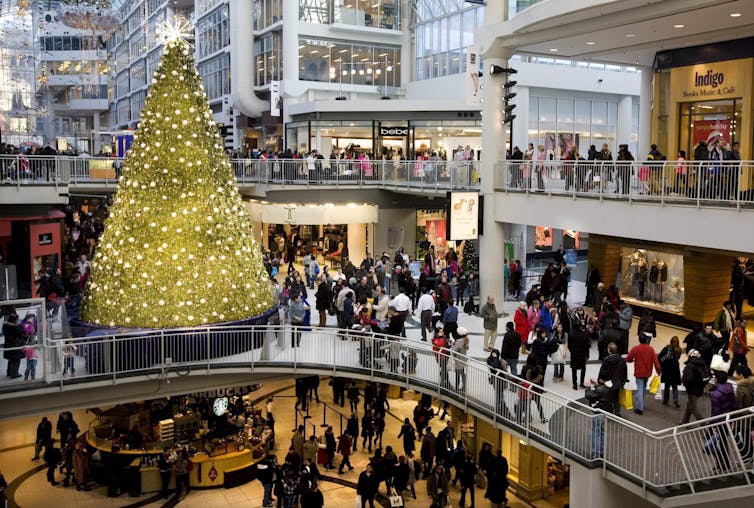Lead image by AP Photo/Mary Altaffer
By Farzam Sepanta
This article is republished from The Conversation under a Creative Commons licence. All photos provided by The Conversation from various sources.
The holiday season is here, and some may plan to go shopping along local Main Streets, popular city districts, malls or to enjoy time with friends and family in restaurants.
If you plan a trip to New York or Toronto for the coming holiday, you might have places like Fifth Avenue or Yorkville on your list as destinations.
But what makes some shops different than others? What makes Fifth Avenue or Yorkville different than other streets?
How we perceive our surrounding environment depends on how we approach and explore places, our perception of time spent doing so and many other components of how a space is designed.
Do we really enjoy holiday shopping?
Aside from finding our preferred brands in certain shops or along these major shopping streets, many of us enjoy spending time strolling those streets or in our local malls.
After all, the concept of retail therapy emerged in the 1980s and centred around getting good feelings and positive vibes from shopping in your preferred location.
Entire malls have been built as awe-inspiring or feel-good destinations, whether or not we agree that shopping itself is really something we enjoy. Is it buying merchandise that gives us a good feeling or is it more the atmosphere of the place we’re visiting?
Components of a space
In his book Questions of Perception, New York-based architect Steven Holl discusses how we perceive our surrounding environment by approaching and walking in a space (also known as circulation) and the components of that space.
According to Holl, we capture a frame of the space we are experiencing with every single step. But our experience depends on many different components, including lights, colours, textures, details, greenery and even the people around us.
All these components are merged into one single frame that forms our experience of a space.

THE CANADIAN PRESS/Jacques Boissinot
Holiday season: Colours, light and sound
Scientific evidence shows different colours have different impacts on our moods. For instance, the colour red can increase appetite in a restaurant; that’s likely why so many seats in fast-food restaurants are in warm colours.
Similarly, green can make us feel peaceful and safe; that’s the reason behind using it in your local health-care clinic.
But colours alone won’t do the job — light is a major component in our built environment. Lighting design contributes significantly to how we perceive our environments.
Many restaurants, for example, use lighting to create an atmosphere at each table and might combine it with candles for an elevated experience. Libraries, on the other hand, provide sufficient lighting levels to desks so people can read with ease.

(Nick Karvounis/Unsplash)
Ambient sounds of streets and malls
Sound is another major contributor to our perception. The sound of rain can intensify a romantic walk by the river. Similarly, you might recognize some streets by the ambient sound. We all experience this ambient sound in our local malls.
We might also experience a particular space through a specific smell. We all have the common experience of smelling perfume that reminds us of someone.
All these space components are used in shopping districts or malls to give visitors a unique experience. It’s all intended to give visitors a positive vibe that will make them return and spend time and money.

THE CANADIAN PRESS/Darren Calabrese
Details and materials
Details are an essential element in architecture to the extent that some brands are known simply for the unique architecture of their retail stores. A golden placard on a black background or golden linear light amid a dark ambient hue are details that can contribute to surrounding environments.
These details can expand into our malls and shopping districts to include greenery and ornamental water fountains, for example. Materials are another vital component of our built environment.
Sitting on a wooden chair feels different than sitting on a metal chair. In a similar fashion, we perceive our environments based on the materials that are used to create a space.

THE CANADIAN PRESS/Justin Tang
Perception of time
The past and future are two concepts in our minds. The present is the reality that we continuously experience as a series of single frames through our senses. For a better understanding, think of a film that we perceive through our seven senses.
Technically, duration is the recognition of changes in that series of single frames. Duration is how we experience more than one frame.
For instance, if we walk down a long straight street, the task of walking might become arduous, resulting in thinking about why it’s taking so long to reach the destination.
In contrast, when we browse different retail stores, coffee shops and so on in a local market or mall, there are constantly changing frames. That’s why we find ourselves shopping for hours in a mall without feeling tired — and why walking for 20 minutes down a long straight street feels too long.

THE CANADIAN PRESS/Sean Kilpatrick
When more senses are stimulated in perceiving our surroundings, our experience is elevated, resulting in different perceptions of time.
Now we know why sometimes walking on a uninteresting street for 30 minutes might seem arduous to us, but browsing and shopping for five hours in our local shopping mall or bustling street is fun.
Details, materials, light and all other components of our built environment impact our experiences of the spaces surrounding us. These, in turn, affect our perception of time and duration.
So, next time, whether you are planning to visit your local mall or a new city, you can identify what components most impact your perception in our built environment. This can help you decide whether you want to visit a specific location again next time.
![]()
Wednesday, December 14, 2022 in The Conversation
Share: Twitter, Facebook



